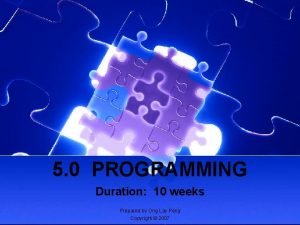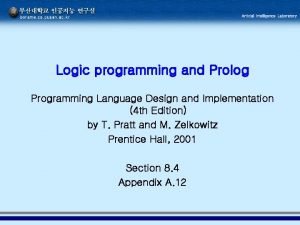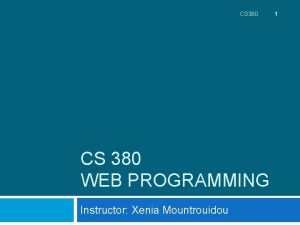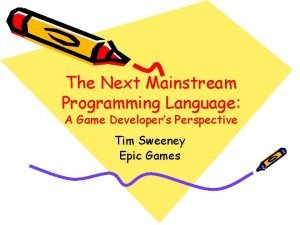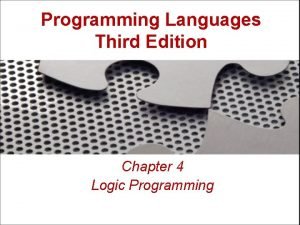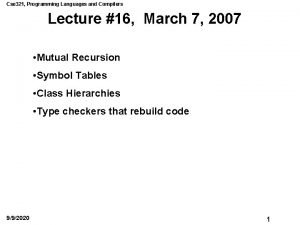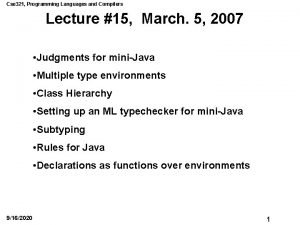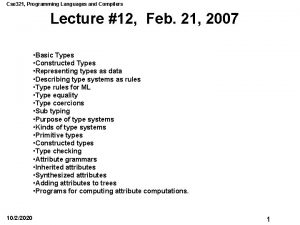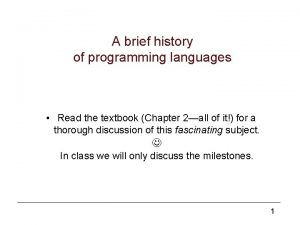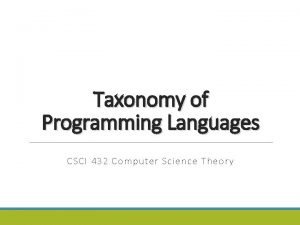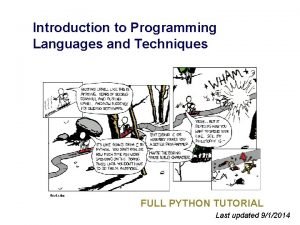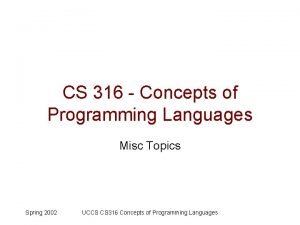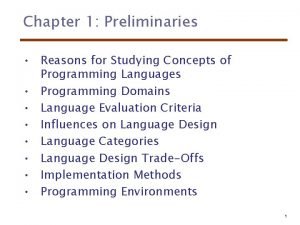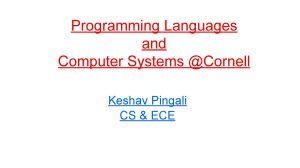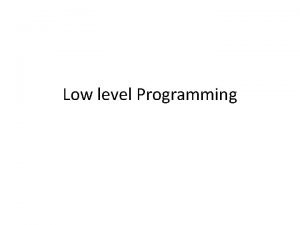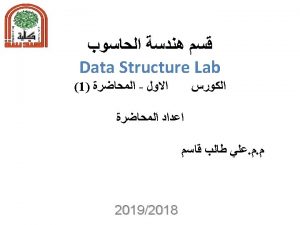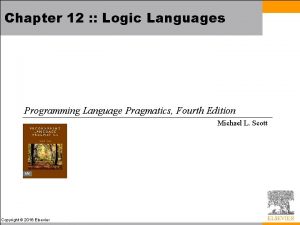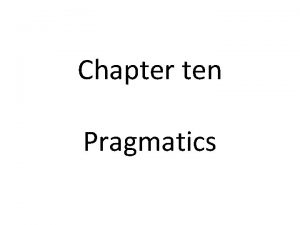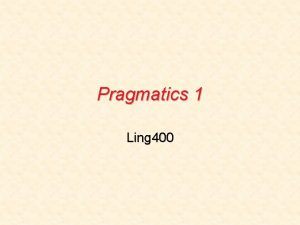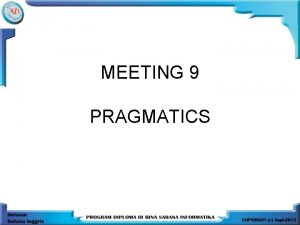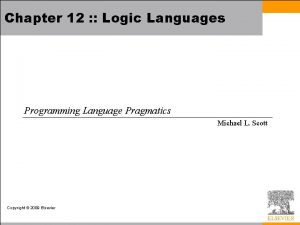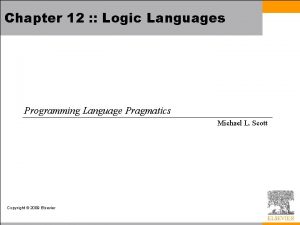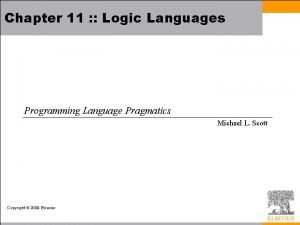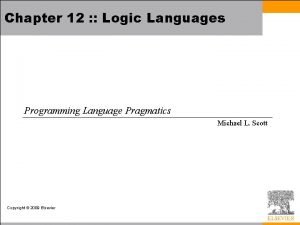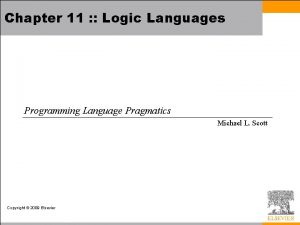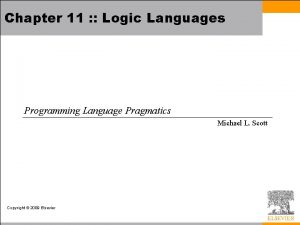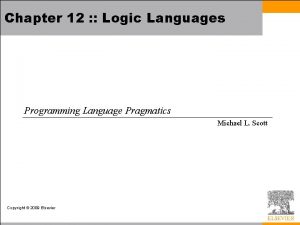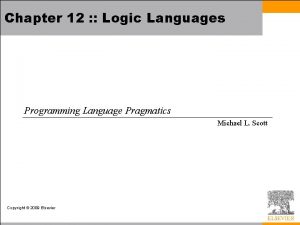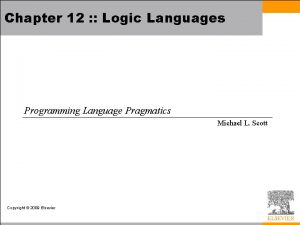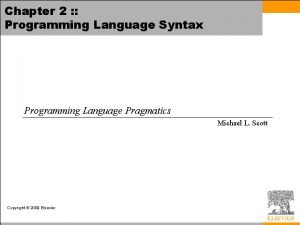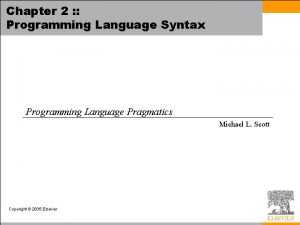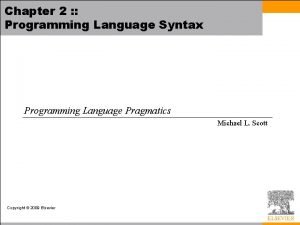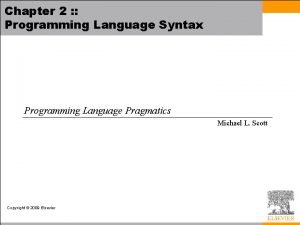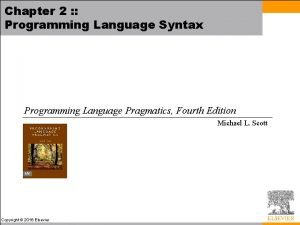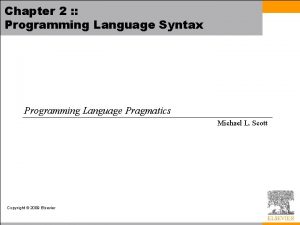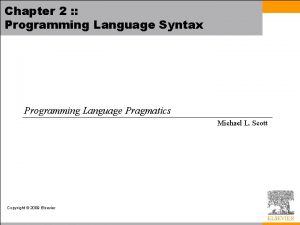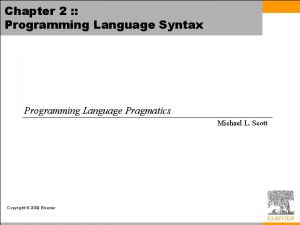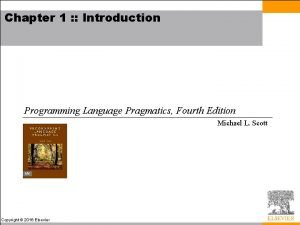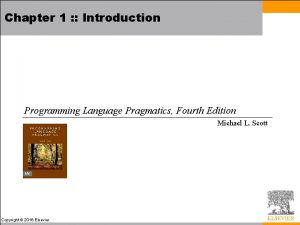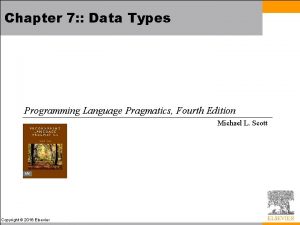Chapter 12 Logic Languages Programming Language Pragmatics Fourth

































- Slides: 33

Chapter 12 : : Logic Languages Programming Language Pragmatics, Fourth Edition Michael L. Scott Copyright © 2016 Elsevier

Logic Programming • Based on predicate calculus • Predicates - building-blocks P(a 1, a 2, . . . , a. K) – limit(f, infinity, 0) – enrolled(you, CS xxx) – These are interesting because we attach meaning to them, but within the logical system they are simply structural building blocks, with no meaning beyond that provided by explicitlystated interrelationships

Logic Programming Concepts • Operators – conjunction, disjunction, negation, implication • Universal and existential quantifiers • Statements – sometimes true, sometimes false, often unknown – axioms - assumed true – theorems - provably true – hypotheses (goals) - things we'd like to prove true

Logic Programming Concepts • Example statements: all f, l [ limit(f, x 0, l) <=> (all e [ e > 0 => (exists d [ d > 0 and all x [ ((|x-x 0| < d) => (|f(x)-l|) < e)]])])] all f, g [f = O(g) <= (exist c, n 0 [ all n [ n > n 0 => f(n) < cg(n)]])]

Logic Programming Concepts • Most statements can be written many ways • That's great for people but a nuisance for computers – It turns out that if you make certain restrictions on the format of statements you can prove theorems mechanically – That's what logic programming systems do – Unfortunately, the restrictions that we will put on our statements will not allow us to handle most of theorems you learned in math, but we will have a surprising amount of power left anyway

Logic Programming Concepts • We insist that all statements be in the form of HORN CLAUSES consisting of a HEAD and a BODY – The head is a single term – The body is a list of terms – A term can be a constant, variable, or STRUCTURE consisting of a FUNCTOR and a parenthesized list of arguments

Logic Programming Concepts • A structure can play the role of a data structure or a predicate – A constant is either an ATOM or a NUMBER – An atom is either what looks like an identifier beginning with a lowercase letter, or a quoted character string – A number looks like an integer or real from some more ordinary language – A variable looks like an identifier beginning with an uppercase letter – There are no declarations – All types are discovered implicitly

Logic Programming Concepts • The meaning of the statement is that the conjunction of the terms in the body implies the head – A clause with an empty body is called a FACT – A clause with an empty head is a QUERY, or top-level GOAL – A clause with both sides is a RULE • The Prolog interpreter has a collection of facts and rules in its DATABASE – Facts are axioms - things the interpreter assumes to be true

Prolog • Prolog can be thought of declaratively or imperatively: – We’ll emphasize the declarative semantics for now, because that's what makes logic programming interesting – We'll get into the imperative semantics later • Prolog allows you to state a bunch of axioms – Then you pose a query (goal) and the system tries to find a series of inference steps (and assignments of values to variables) that allow it to prove your query starting from the axioms

Prolog • The meaning of the statement is that mother(mary, fred). % you can either think of this as % a predicate asserting that mary % is the mother of fred % or a data structure (tree) % in which the functor (atom) % mother is the root, % mary is the left child, and % fred is the right child fat(albert). rainy(rochester).

Prolog • Rules are theorems that allow the interpreter to infer things • To be interesting, rules generally contain variables employed(X) : - employs(Y, X). can be read: for all X, X is employed if there exists a Y such that Y employs X • Note the direction of the implication: – The example does NOT say that X is employed ONLY IF there is a Y that employs X

Prolog • The scope of a variable is the clause in which it appears – Variables whose first appearance is on the left hand side of the clause have implicit universal quantifiers – Variables whose first appearance is in the body of the clause have implicit existential quantifiers • Similarly:

Prolog grandmother(A, C) : - mother(A, B), mother(B, C). can be read: for all A, C [A is the grandmother of C if there exists a B such that A is the mother of B and B is the mother of C]. We probably want another rule that says grandmother(A, C) : - mother(A, B), father(B, C).

Prolog • To run a Prolog program, one asks the interpreter a question – This is done by stating a theorem - asserting a predicate - which the interpreter tries to prove • If it can, it says yes • If it can't, it says no • If your predicate contained variables, the interpreter prints the values it had to give them to make the predicate true.

Prolog • The interpreter works by what is called BACKWARD CHAINING – It begins with the thing it is trying to prove and works backwards looking for things that would imply it, until it gets to facts • It is also possible in theory to work forward from the facts trying to see if any of the things you can prove from them are what you were looking for - that can be very timeconsuming – Fancier logic languages use both kinds of chaining, with special smarts or hints from the user to bound the searches

Prolog • The predicate you ask for is the interpreter's original GOAL – In an attempt to SATISFY that goal, it looks for facts or rules with which the goal can be UNIFIED • Unification is a process by which compatible statements are merged – Any variables that do not yet have values but which correspond to constants or to variables with values in the other clause get INSTANTIATED with that value – Anyplace where uninstantiated variables correspond, those variables are identified with each other, but remain without values

Prolog • The interpreter starts at the beginning of your database (this ordering is part of Prolog, NOT of logic programming in general) and looks for something with which to unify the current goal – If it finds a fact, great; it succeeds – If it finds a rule, it attempts to satisfy the terms in the body of the rule depth first – This process is motivated by the RESOLUTION PRINCIPLE, due to Robinson: • It says that if C 1 and C 2 are Horn clauses, where C 2 represents a true statement and the head of C 2 unifies with one of the terms in the body of C 1, then we can replace the term in C 1 with the body of C 2 to obtain another statement that is true if and only if C 1 is true

Prolog • When it attempts resolution, the Prolog interpreter pushes the current goal onto a stack, makes the first term in the body the current goal, and goes back to the beginning of the database and starts looking again • If it gets through the first goal of a body successfully, the interpreter continues with the next one • If it gets all the way through the body, the goal is satisfied and it backs up a level and proceeds

Prolog • If it fails to satisfy the terms in the body of a rule, the interpreter undoes the unification of the left hand side (this includes uninstantiating any variables that were given values as a result of the unification) and keeps looking through the database for something else with which to unify (This process is called BACKTRACKING) • If the interpreter gets to the end of database without succeeding, it backs out a level (that's how it might fail to satisfy something in a body) and continues from there

Prolog • We can visualize backtracking search as a tree in which the top-level goal is the root and the leaves are facts (see Figure 12. 2 - next slide) – The children of the root are all the rules and facts with which the goal can unify – The interpreter does an OR across them: one of them must succeed in order for goal to succeed – The children of a node in the second level of the tree are the terms in the body of the rule – The interpreter does an AND across these: all of them must succeed in order for parent to succeed – The overall search tree then consists of alternating AND and OR levels

Prolog

Prolog • PROLOG IS NOT PURELY DECLARATIVE – The ordering of the database and the left-toright pursuit of sub-goals gives a deterministic imperative semantics to searching and backtracking – Changing the order of statements in the database can give you different results • It can lead to infinite loops • It can certainly result in inefficiency • Tree relationships:

Prolog parent(a, b). parent(a, d). parent(a, k). parent(k, l). parent(k, m). parent(b, e). parent(b, f). parent(f, g). parent(f, h). parent(f, i). % a is the parent of b ancestor(X, Y) : - parent(X, Y). ancestor(X, Y) : - parent(Z, Y), ancestor(X, Z).

Prolog • Then the question ? - ancestor(U, h). generates the answers U = f; U = b; U = a; no • The question ? - ancestor(b, U). generates all nodes in the subtree rooted in b << trace >>

Prolog • If we change the order of the two ancestor rules, we get different execution orders: ? - ancestor(U, h). U = a; U = b; U = f; no • If we change the order of the subgoals in the compound rule, ancestor(X, Y) : - ancestor(X, Z), parent(Z, Y). we run into an infinite loop (see also Figure 12. 2)

Prolog • Arithmetic: The '=' operator determines whether its operands can be unified ? - A = 37 yes ? - 2 = 2. yes Math operators are functors (structure names), not functions ? - (2+3) = 5 no

Prolog • For math we use the built-in operator is ? - is(X, 1+2). X = 3 yes ? - X is 1+2. X = 3 yes % LHS of 'is' must be as-yet uninstantiated ? - 1+2 is 4 -1. no % RHS of 'is' must already be instantiated ? - X is Y. <error>

Prolog • Tic-tac-toe (see Figure 12. 3 on next slide) – This program finds the next move, given a board configuration – It does not play a whole game (see the book for an extended version that does) – It depends on the ordering of rules • move(A) is the root rule • A is a result parameter – No winning strategy • each player can force a draw

Prolog

Logic Programming Examples % express that three given squares lie in a %line ordered_line(1, 2, 3). ordered_line(4, 5, 6). ordered_line(7, 8, 9). ordered_line(1, 4, 7). ordered_line(2, 5, 8). ordered_line(3, 6, 9). ordered_line(1, 5, 9). ordered_line(3, 5, 7). line(A, B, C) : - ordered_line(A, C, B). line(A, B, C) : - ordered_line(B, A, C). line(A, B, C) : - ordered_line(B, C, A). line(A, B, C) : - ordered_line(C, A, B). line(A, B, C) : - ordered_line(C, B, A) % we assume a not so perfect opponent

Prolog % the following rules work well move(A) : - good(A), empty(A). full(A) : - x(A). full(A) : - o(A). empty(A): - not full(A) % strategy (key is ordering following five rules) good(A) : - win(A). good(A) : - block_win(A). good(A) : - split(A). good(A) : - block_split(A). good(A) : - build(A).

Prolog % first choice is to win(1) win(A) : - x(B), x(C), line(A, B, C). % block opponent from winning (2) block_win(A) : - o(B), o(C), line(A, B, C). % opponent cannot block us from winning next % see Figure 11. 6 before for this case(3) split(A) : - x(B), x(C), different(B, C), line(A, B, D), line(A, C, E), empty(D), empty(E). same(A, A). different(A, B) : - not same(A, B).

Prolog % prevent opponent from creating a split (4) block_split(A) : - o(B), o(C), different(B, C), line(A, B, D), line(A, C, E), empty(D), empty(E). % pick a square toward three in a row (5) build(A) : - x(B), line(A, B, C), empty(C). % if none of the five, final defaults (in this % order) good(5). good(1). good(3). good(7). good(9). good(2). good(4). good(6). good(8).
 Example of fourth generation programming language
Example of fourth generation programming language Prolog designed by
Prolog designed by Expert systems: principles and programming, fourth edition
Expert systems: principles and programming, fourth edition Real-time systems and programming languages
Real-time systems and programming languages Cs 421 uiuc
Cs 421 uiuc Multithreaded programming languages
Multithreaded programming languages Cxc it
Cxc it Introduction to programming languages
Introduction to programming languages Plc programming languages
Plc programming languages Joey paquet
Joey paquet Imperative programming languages
Imperative programming languages Alternative programming languages
Alternative programming languages Strongly typed vs weakly typed
Strongly typed vs weakly typed Transmission programming languages
Transmission programming languages Adam doupe cse 340
Adam doupe cse 340 Integral data types
Integral data types Xenia programming languages
Xenia programming languages Advantages and disadvantages of programming languages
Advantages and disadvantages of programming languages Mainstream programming languages
Mainstream programming languages Cse 340 principles of programming languages
Cse 340 principles of programming languages Programming languages
Programming languages Programming languages
Programming languages Programming languages
Programming languages Programming languages
Programming languages Tiny programming language
Tiny programming language Brief history of programming languages
Brief history of programming languages Lisp_q
Lisp_q Real time programming language
Real time programming language Low level language
Low level language If programming languages were cars
If programming languages were cars Reasons for studying concepts of programming languages
Reasons for studying concepts of programming languages Cornell programming languages
Cornell programming languages Low level programming languages
Low level programming languages Middle level programming languages
Middle level programming languages
